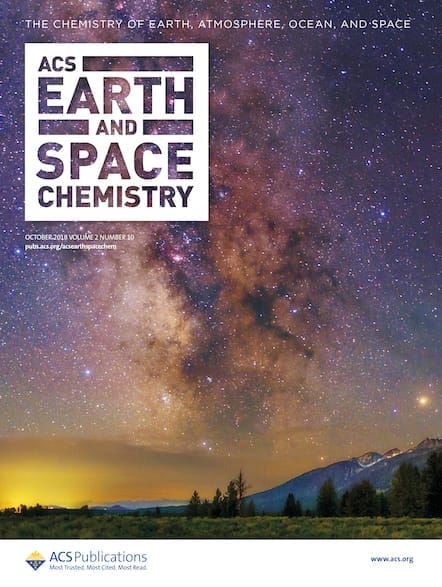ACS Earth and Space Chemistry publishes high quality research on the chemistry of the earth surface, earth interior, atmosphere, oceans, space, and analytical methods. The journal is currently inviting submissions for two upcoming Special Issues on “Complex Organic Molecules (COMs) in Star-Forming Regions” and “New Advances in Organic Aerosol Chemistry”. Read more below for further […]

Submit Your Papers Today!
Special Issue: “Complex Organic Molecules (COMs) in Star-Forming Regions”
Deadline: April 1, 2019
In the last 50 years, astronomers have discovered a large number of molecules in interstellar clouds of gas and dust, both in our galaxy and others. The gas phase of the dense interstellar clouds is observed to be replete with molecules ranging in size up to thirteen atoms. The dust particles in the colder regions of clouds are covered by mantles of assorted ices including water and carbon dioxide. Although the molecules in the gas are mainly organic in nature, some of them are very exotic by terrestrial standards, including radicals, positively and negatively charged ions, unusual isomers, and hydrogen-poor species despite the fact that hydrogen is the most abundant element in the universe. Because interstellar clouds are the birthplace of new stars and planets, the chemistry occurring during the collapse of portions of these clouds as star formation proceeds is likely related to the chemistry that occurs as planets are formed. This special issue will be concerned with the more complex of these interstellar molecules, known loosely by the acronym COMs (Complex Interstellar Molecules) in all of the evolutionary stages of star formation from denser portions of cold clouds, to warmer objects formed as collapse proceeds, to protoplanetary disks surrounding stars in the act of formation, in which dust particles begin to coalesce into larger objects such as comets and meteors, and finally to planets. Both the current knowledge of the chemistry occurring in the gas and on dust particles during these stages and how we can learn about the details of stellar and planetary formation from observations of complex molecules will be subjects to be probed.
Topics of interest include but are not limited to:
- Gas-phase and grain-surface reactions leading to COMs including irradiation of carbonaceous ices by high-energy cosmic rays, studied both experimentally and theoretically
- Solar system chemistry including the formation of COMs in comets and meteors, where much larger molecules than COMs including amino acids are known to exist
- Isotopic fractionation especially of deuterium at low temperatures where the abundances of deuterated species can have abundances equal to normal species
- Observations with radio and infrared telescopes of new COMs in a variety of sources including disks and planetary atmospheres
- Chemical simulations of the chemistry that occurs as star formation proceeds using coupled rate equations and Monte Carlo approaches.
Guest Editors:
Kathrin Altwegg, Universität Bern
Cecilia Ceccarelli, Université Grenoble Alpes
Eric Herbst, University of Virginia (Associate Editor, ACS Earth and Space Chemistry)
Gianfranco Vidali, Syracuse University
Submit Your Paper
Special Issue: “New Advances in Organic Aerosol Chemistry”
Deadline: May 1, 2019
Guest Editor:
Faye McNeill, Columbia University, Associate Editor, ACS Earth and Space Chemistry
